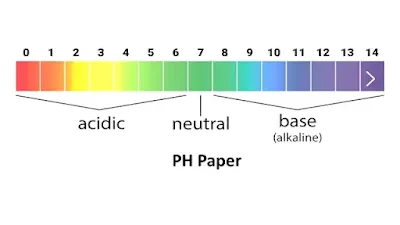If you are looking for NCERT Science Class 10 Chapter 4 Activity solutions, then you are in the right place. In this post, you will find NCERT Activity 4.7 Class 10 Science Explanation with conclusion.
NCERT Activity 4.7 Class 10 Science
You are
suggested to study NCERT activity 4.7 class 10 science explanation with a conclusion so that you can attempt questions based on activity 4.7 class 10
science.
Table of Content
1. Activity
2. Observation
3. Conclusion
4. Quiz
6. FAQs
Activity 4.7 Class 10 Science
· Compare
the `P^H` of dilute acetic acid and dilute hydrochloric acid using both litmus and
universal indicators.
· Are
both acids indicated by the litmus test?
· Does
the universal indicator show them as equally strong acids?
Observation
Litmus paper is a `P^H` indicator that changes colour
when comes in contact with acidic or alkaline solutions. It is available in
red or blue colour.
Acids change
blue litmus paper into red while base (alkali) change red litmus into blue.
|
Acids |
Red litmus paper
|
Blue litmus
paper |
|
Hydrochloric
acid |
No change in colour |
Change into red |
|
Acetic acid |
No change in colour |
Change into red |
When blue litmus paper is dipped into a dilute acetic acid
solution. It becomes slightly red.
When blue litmus paper is dipped into dilute hydrochloric
acid, it becomes red
So this indicates both acetic acid and hydrochloric acid
are acidic in nature.
Now we add a universal indicator in both acetic acid and
hydrochloric solutions and observe the result.
|
Acids |
Universal indicator |
PH value |
|
Hydrochloric
acid |
light
pink colour |
Approx 2 |
|
Acetic acid |
yellowish pink
colour |
Approx 4 |
Universal indicator is also a `P^H` indicator but it has a wide
range of PH and provides more clear results.
When a universal indicator is added to dilute acetic
acid, it shows `P^H` in the range of 3 to 6 which indicates that acetic acid is a
mild acid.
When a universal indicator is added to dilute acetic acid, it shows the `P^H` below 3 (approx 2)which indicates that HCl is a strong acid.
i. Both litmus and universal indicators show that dilute acetic acid and hydrochloric acids are acidic solutions.
ii. Universal indicator shows that HCl is stronger than acetic acid.
Activity 4.7 Class 10 Science Conclusion
This activity shows that HCl is completely ionized while acetic acid is only
partly ionized, therefore, we can say that hydrochloric acid is a stronger acid than
acetic acid.
Quiz on Activity 4.7 Class 10 Science
Important Question based on activity 4.7 Class 10 Science
1. How are carboxylic acids different from mineral acids from an ionization point of view?
Ans. – Mineral acids are completely ionized but carboxylic acids are partly ionized.
2. What is a universal indicator?
Ans.- A universal indicator is a PH made of a solution of several compounds that indicate the acidity or alkalinity of different solutions.
3. What is the conclusion of activity 4.7 class 10 science?
Ans- It is concluded that `HCl` is stronger than `CH_3COOH`.
4. What is the aim of activity 4.7 class 10 science?
Ans - The aim of activity 4.7 is to find whether the given solutions are acidic or basic.
5. Why hydrochloric acid is stronger than `CH_3COOH`?
Ans - Hydrochloric and completely ionised while acetic acid ionised partially.
6. Does the litmus test show which acid is strong?
Ans- No, the litmus test doesn’t show which acid is strong.
FAQs
1. Why litmus paper is used in this activity 4.7 Class 10
Science?
Ans - Litmus
paper is used as an indicator based on colour change with acidic or basic
solutions.
2. How does blue litmus paper change when dipped in
hydrochloric acid solution?
Ans - Blue litmus paper changes to red colour.
3. What colour change is observed when blue litmus paper
is dipped in acetic acid?
Ans - There is no change in colour.
4. Does the litmus paper test indicate whether `HCl` and `CH_3COOH` are acids?
Ans - Yes,
litmus paper changes its colour (blue to red) with both `HCl` and `CH_3COOH` showing
both are acidic.
5. Is universal indicator better than litmus paper in
activity 4.7 class 10 science?
Ans- Yes, the universal indicator is better than
litmus paper as it has a wide PH range.
6. What colour does the universal indicator show with `HCl`?
Ans- Universal indicator shows pink colour with `HCl`.
7. What `P^H` value is shown by a universal indicator in `HCl`?
Ans -
Universal indicator shows `P^H` value approx 2 (below 3).
8. Does the universal indicator show a clear difference
between `HCl` and `CH_3COOH`?
Ans - Yes,
universal does. The universal indicator has a wide range of `P^H`.
9. What is the `P^H` range shown by the universal indicator
in acetic acid?
Ans - It shows a `P^H` range of 3 to 6.
Related Topics
1. Activity 4.8 Class 10 Science
2. Activity 4.6 Class 10 Science
3. Solution of Chapter 4 Carbon and its Compounds
5. Extra Questions of Chapter 4


.jpg)

